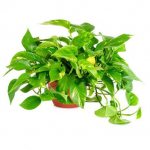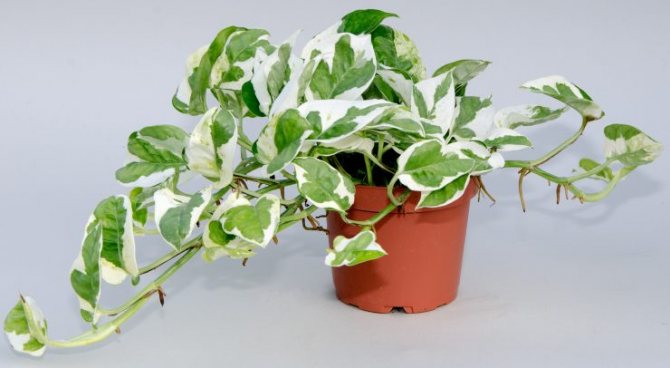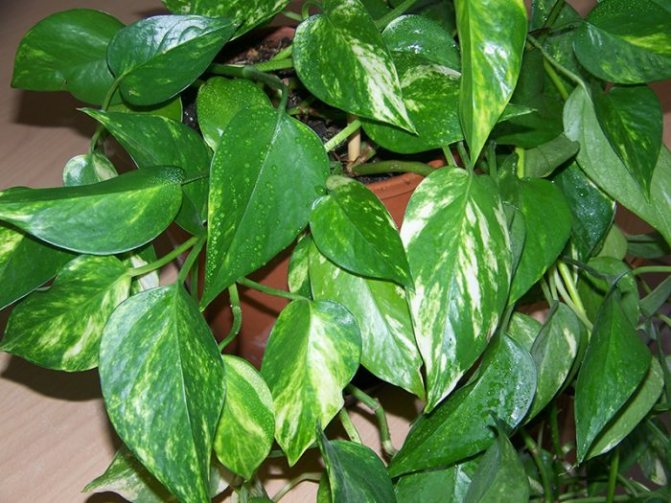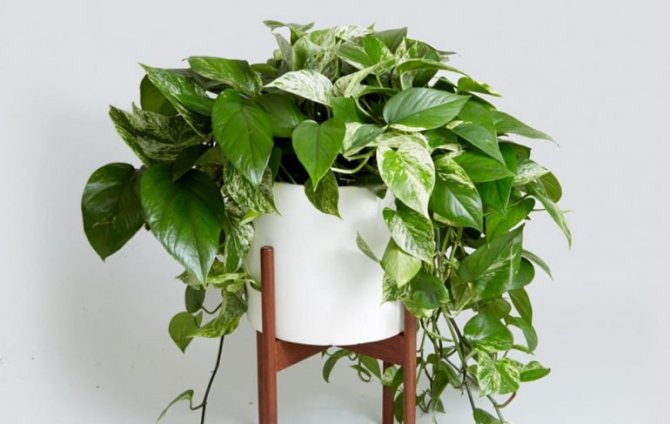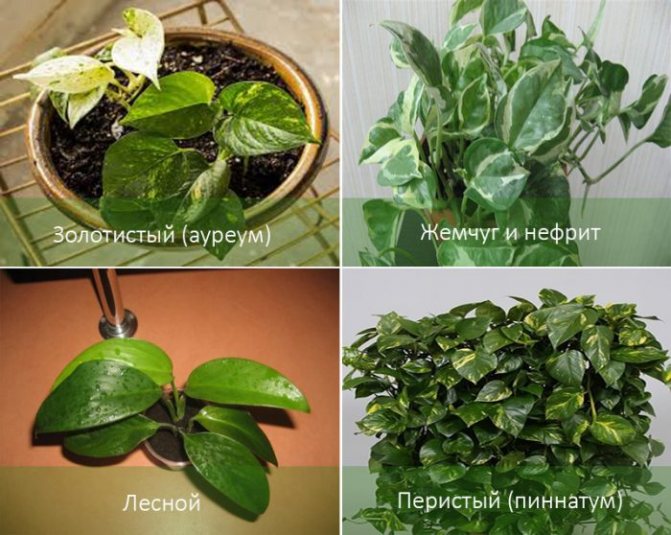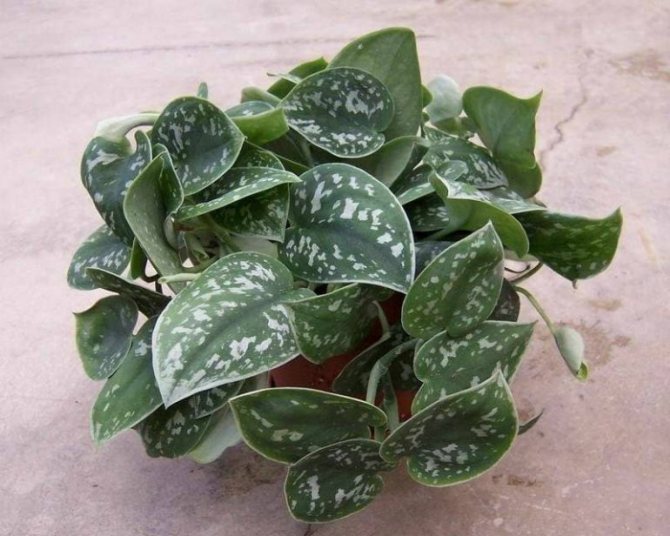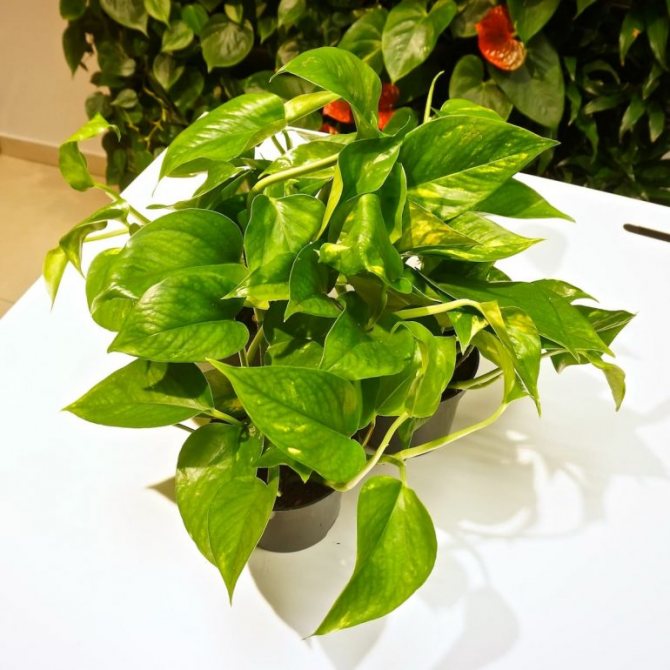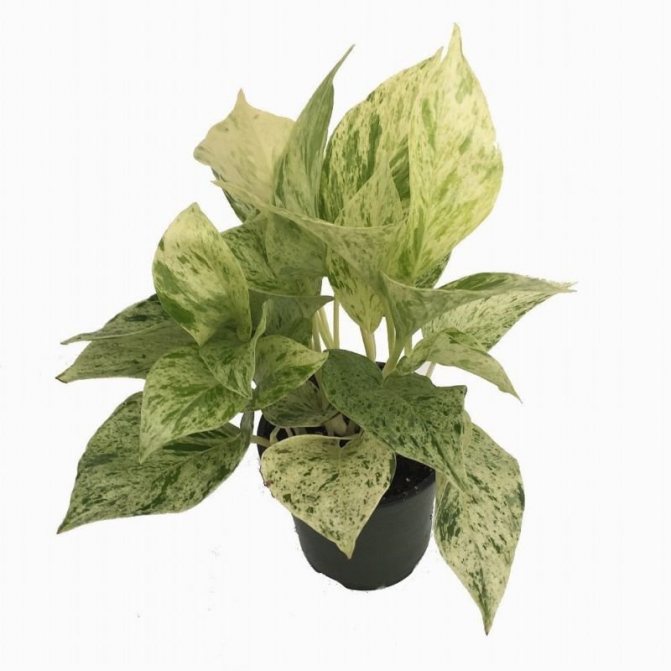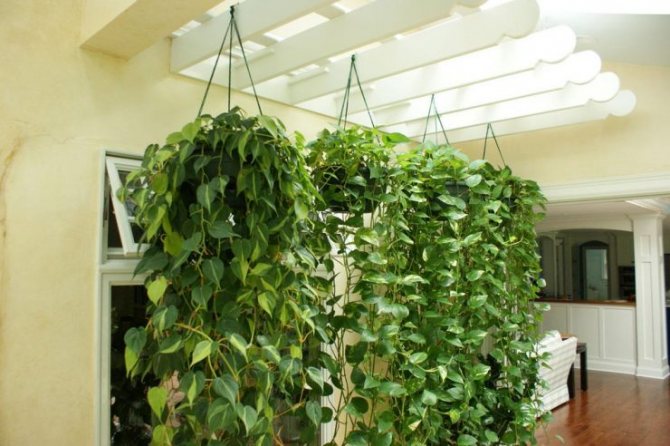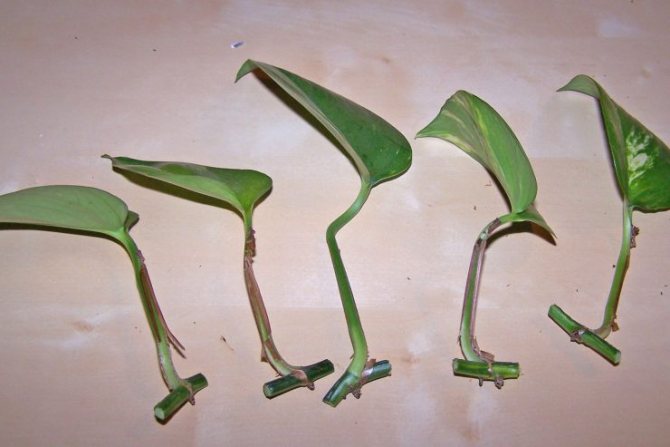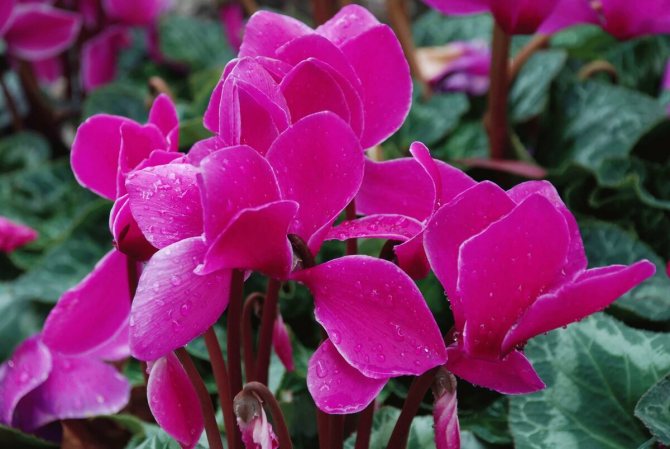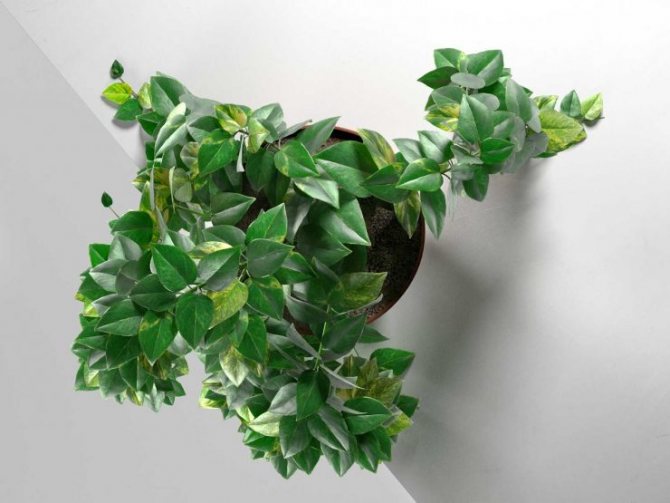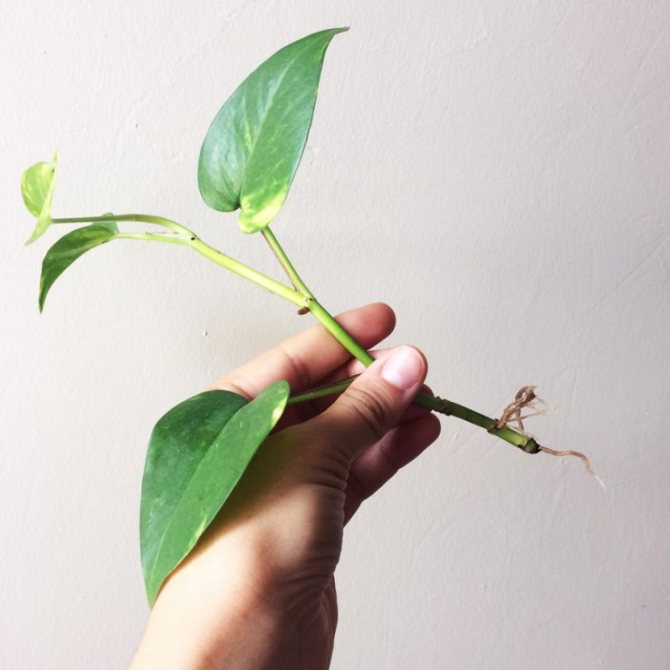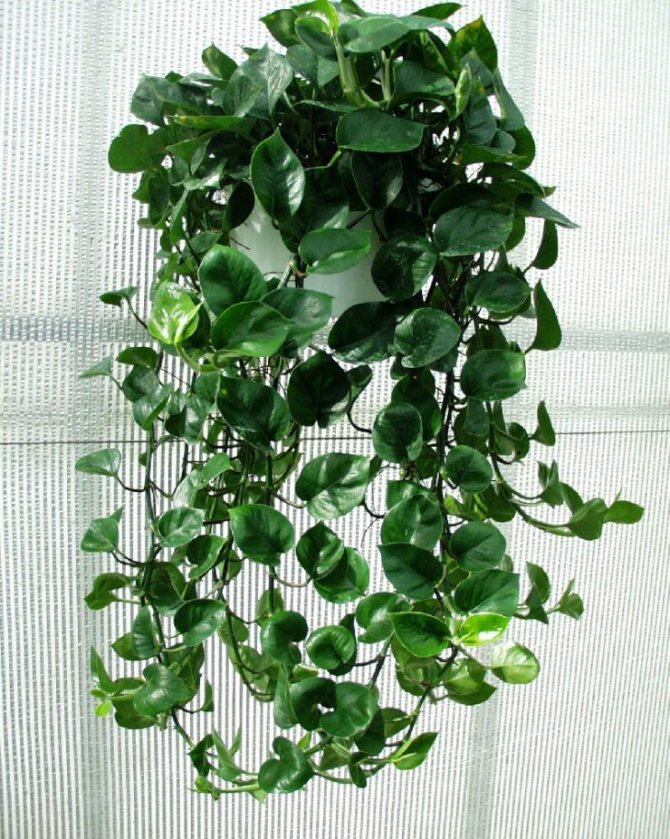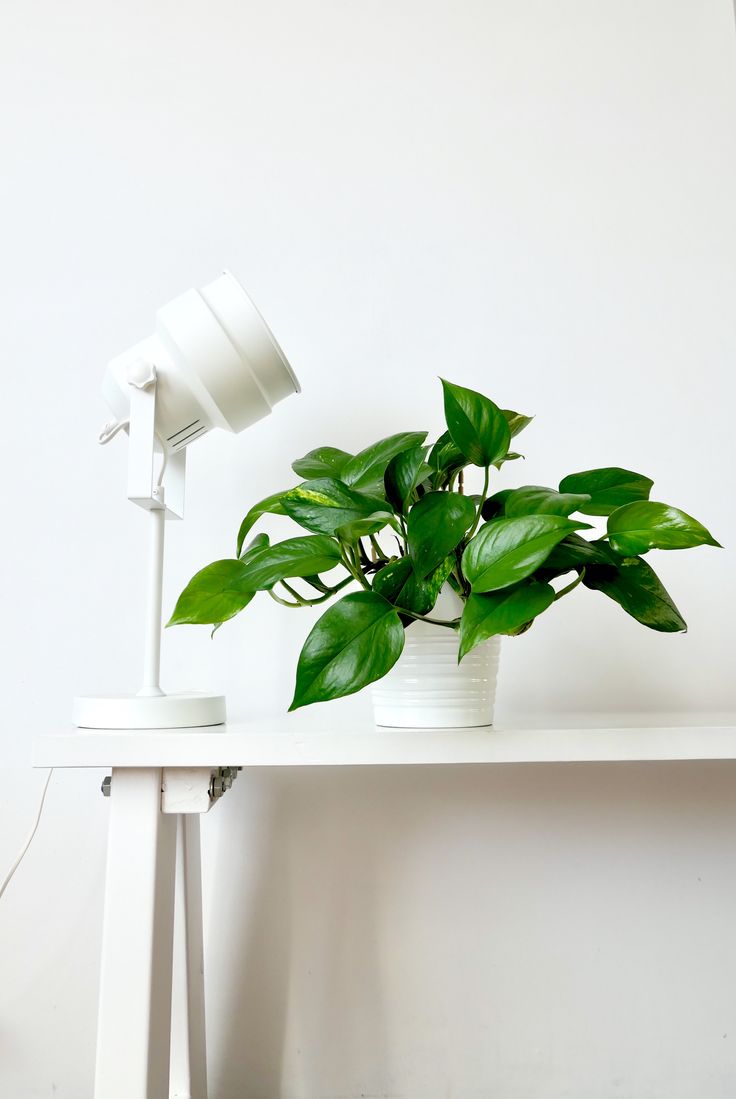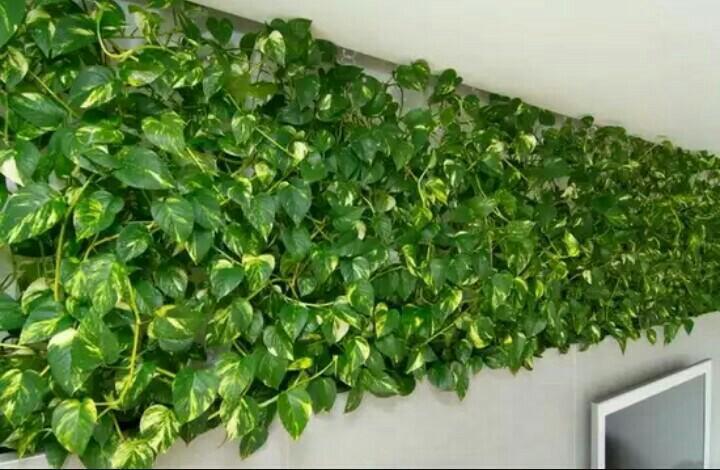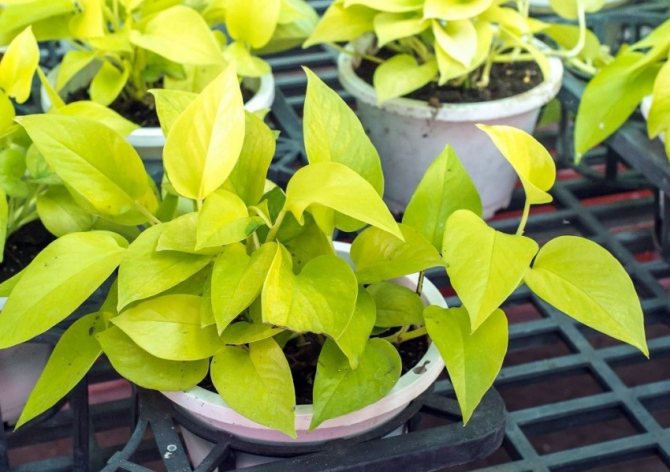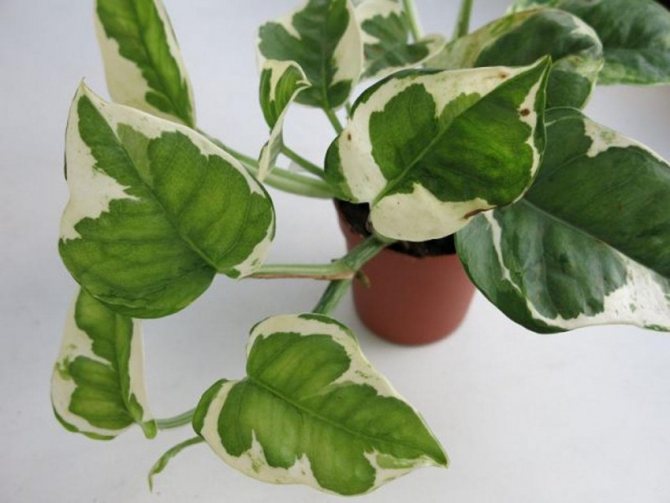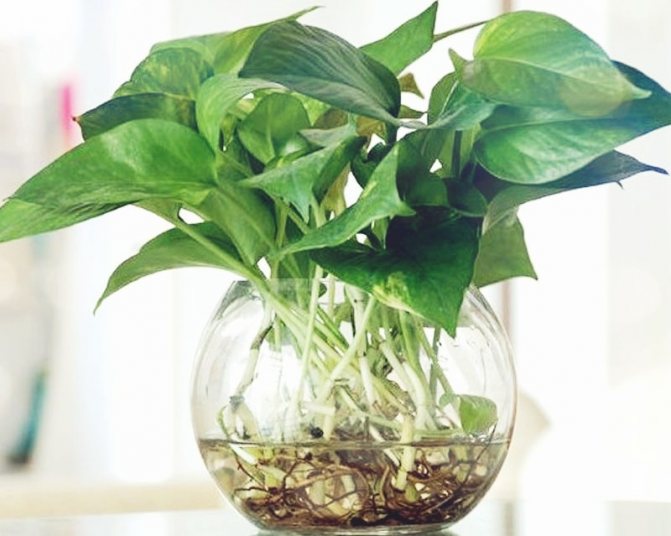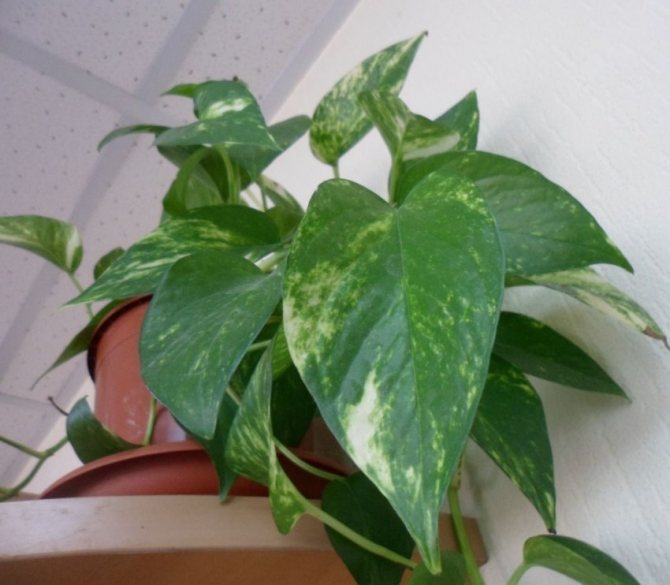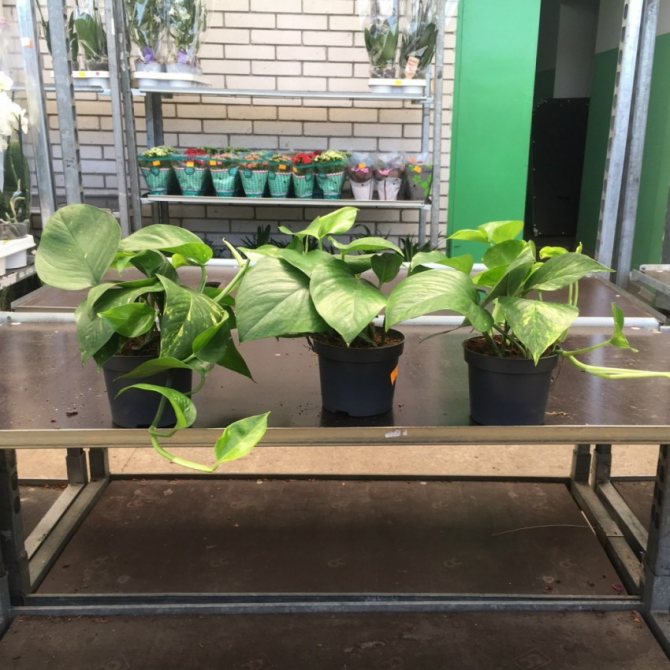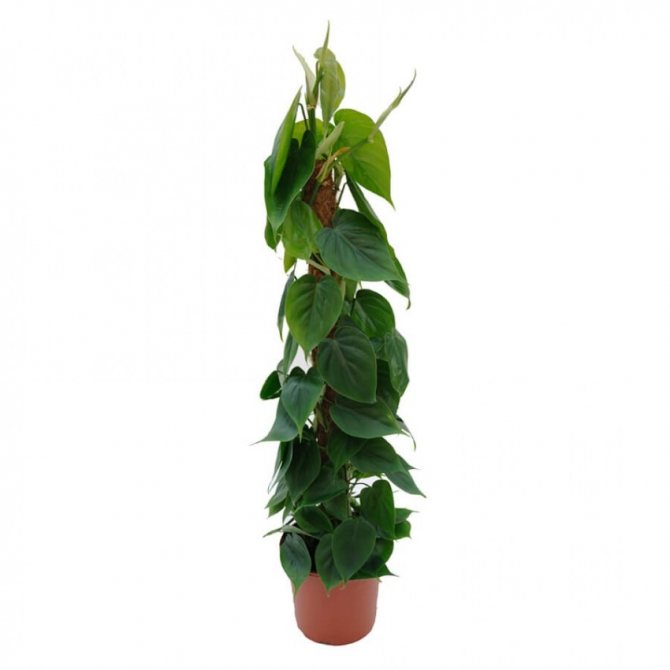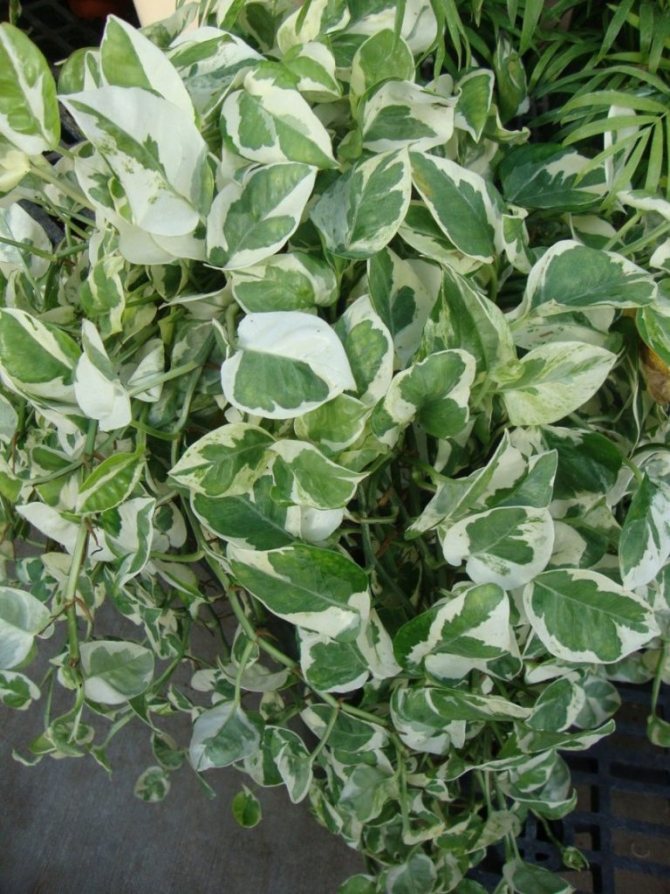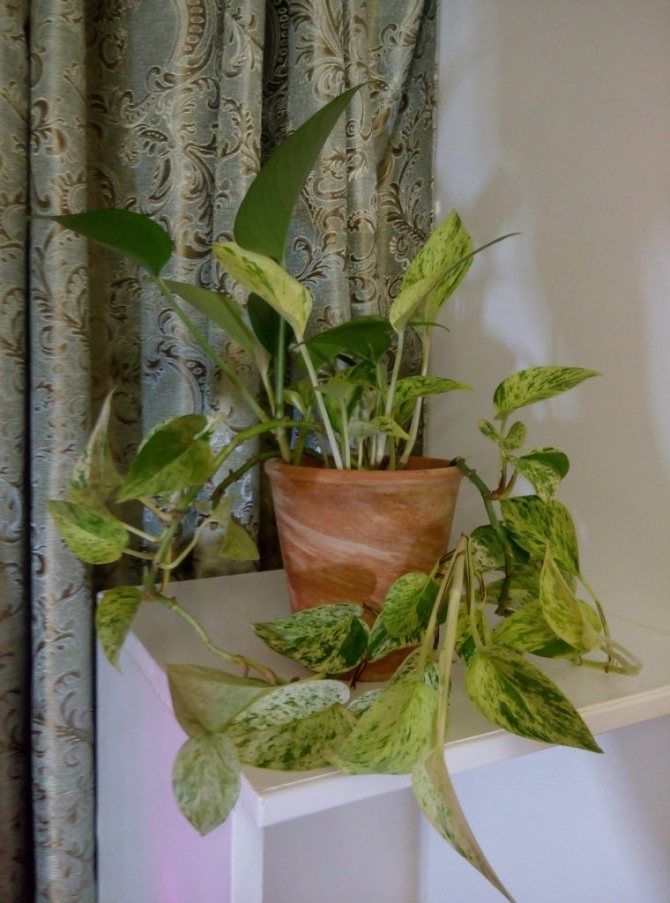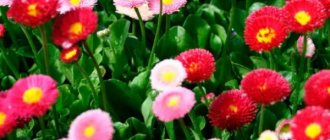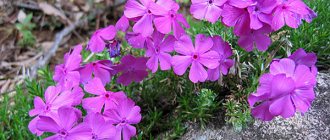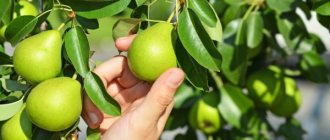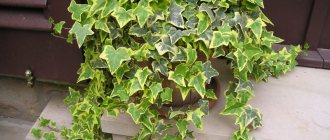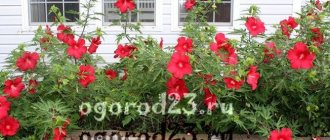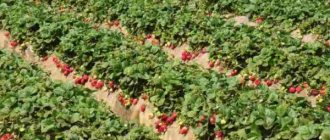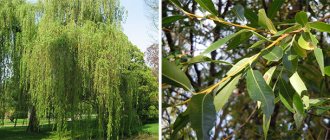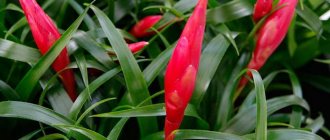Photo of the plant Epipremnum (Epipremnum), or scindapsus is one of the most popular varieties of perennial vines, related to branchy ampelous forms of vegetation.
The flower has a huge number of varieties, but mostly it is strongly climbing vines, decorated with rich variegated green leaf plates, which can effectively decorate any interior of an office, apartment, or private house. They belong to the Aroid family.
In natural conditions, branches can reach up to 38-40 meters in length, which can be spread on the ground, or attached to the trunks of various trees. The home plant grows up to 4.5 meters. He is not whimsical in leaving.
In growth, it adds up to 45 cm per year. It blooms only in natural conditions from spring to late autumn. Flowers in the form of a cob with a veil have no special value, therefore the plant has more value as a decorative one. The homeland of Epipremnum is the tropics of southeast Asia, the Slomonov Islands and the Malay archipelago, as well as Indonesia.
See also how to grow zamioculcas and syngonium.
| They have a high development rate - they add up to 45 cm per year. |
| Does not bloom at home. |
| The plant is easy to grow. Suitable for a beginner. |
| Perennial. |
Types and varieties
Epipremnum belongs to the Aroid family. The plant is classified as perennial and evergreen. In nature, about 40 species of these vines are read. They grow in forests from India to Northern Australia. They are also found in Southeast Asia. There are 7 of the most famous vines for home breeding.
Epipremnum cirrus - so named due to the fact that in an adult plant, the leaf often becomes pinnately dissected. It grows no more than 10 meters in height.
Loading ...
Forest epipremnum - small enough, no more than 6 meters tall.
Epipremnum painted - the most decorative of the species.
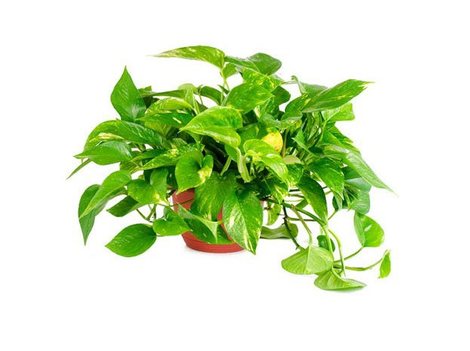
There are also four most common subspecies. Epipremnum golden: «Marble queen», «Golden pothos», «N`Joy»And the usual golden one. "Marble queen»Of them the most popular among florists
- Golden (in Latin Epipremnum aureum).
The second official name is "Golden Scindapsus". This is one of the most common ornamental species, which has beautiful leathery leaves with a variegated golden-yellow scattering of stripes and spots on a dark green background. Their sizes in adult plants: up to 60 cm in length and up to 30–40 in width. The pattern of leaves in individual varieties can differ significantly. For example, in golden pothos, they are almost entirely yellowish-golden, and in the marble queen, the main color is silver-white. - Considering the golden appearance of the epipremnum, one cannot fail to mention the variety Pearls and jade (in lat. Full name Epipremnum aureum "Pearls and Jade").
This variety was bred from the Marble Queen by American growers. Its distinctive feature is its compact dimensions, which are unusual for other decorative representatives of the Epipremnum genus. In a mature plant, the size of the leaves reaches 8 cm in length and 5 cm in width. The color is spotted, consisting of green, white and gray-green shades.You can hardly find two leaves of the same color on one plant, but this is by no means a minus, but on the contrary - the vines of the Pearl and jade varieties look very original. Moreover, the leaves themselves are not smooth, as in most other epipremnums, but are distinguished by a tuberous surface. The stem of the plant is predominantly green with white longitudinal stripes. The petioles are long and almost equal to the leaves that are attached to them. This variety has gained particular popularity not only for its spectacular appearance, but also for its unpretentiousness to growing conditions. The only thing that the plant desperately needs is sufficient illumination, without which the attractive appearance can fade. - The next species is called forest (in lat.E. silvaticum Alderw.)
... This is easily explained, because his homeland is the swampy forests of Sumatra and Indonesia. The plant is a long (up to 6 meters) liana of a very graceful shape. Individual leaves have an oval-lanceolate structure and a beautiful glossy surface of an emerald hue. Leaf sizes: up to 15–20 cm in length and 5–6 cm in width. An interesting decorative look is obtained due to small internodes. - Feathery (in Latin Epipremnum pinnatum).
This variety lives in India and China, and due to its size has earned the title of the largest liana in the entire Araceae family. In places of natural growth, it stretches in length by 35-40 meters! Under artificial conditions, the growth is not so intense and some representatives of cultivated plants demonstrate the length of vines no more than 10 meters. The leaves have a beautiful deep dark green hue, and in adult epipremnums, their shape becomes feathery dissected, for which this species got its name. When grown in residential premises, the plant is completely unpretentious to the conditions, develops at an average speed and does not reach gigantic sizes. - Painted epipremnum (in Latin Scindapsus pictus)
- a kind of angular tall liana, growing up to 15 m. Young plants have a smooth stem, but in the process of growing up, warts form on it, the size and number of which grow every year. The leaves sit on short petioles, are ovoid. They are 12–15 cm long and 6–7 cm wide. The most widespread varieties are argyraeus and exotica. In the first of them, shortened leaves act as a distinctive feature, which at the same time retain the characteristic width of the species and exhibit a deep green color with regular silvery spots. The exotica variety is characterized by a leaf pattern with elongated gray strokes and wide silvery spots.
The benefits and harms of epipremnum
Scientists have found that epipremnum purifies the air. It is recommended to place a planter with a plant in the kitchen. A lot of oxygen is consumed there, and the vine filters the air, eliminating xylene, benzene, formaldehyde.
In the East, there is a belief that epipremnum energizes, improves endurance, helps the development of mental abilities, promotes career advancement, social activities. Improves physical and emotional well-being. A home where a flower grows always has a good atmosphere.
However, epipremnum can also harm humans and pets. The fact is that the plant is toxic. If its extract gets on the mucous membranes, irritation will appear. In severe cases, edema may develop. To avoid adverse consequences, it is recommended to keep the vine away from children and animals: for example, in a hanging planter.


Lighting and temperature control
Epiprenum feels best at room temperature, it should not be lower than 18 degrees. In winter, a mark of 15 degrees is allowed, at this time the plant is resting. It can withstand even a short-term drop in temperature to 12 degrees, but suffers greatly from air conditioners and drafts.
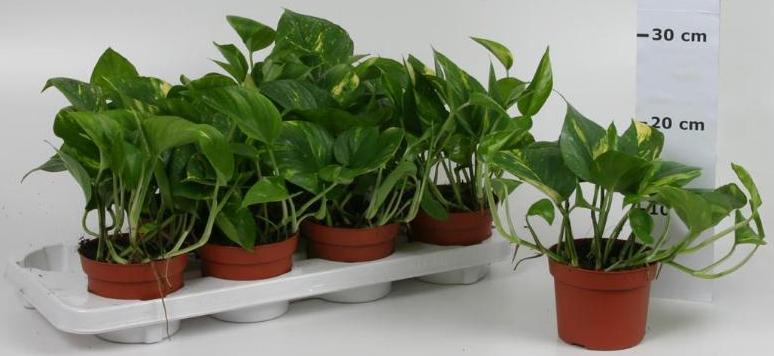

Epipremnum is undemanding for lighting and grows even in shaded areas. However, positioning on a north window with no light or in the corner of a dark room will cause the leaves of the plant to turn completely green and stop developing. But even on a hot southern window, the vine will feel uncomfortable. It is best to place the epiprenum at a distance of 1.5–2 meters from a well-lit window.
Propagation of Epipremnum by cuttings
Reproduction of epipremnum is carried out mainly by apical cuttings, on which there should be at least 2 leaf plates. And you can also propagate this handsome man by dividing the shoot into parts, provided that each of the parts has at least one leaf, from the bosom of which new shoots will develop in the future.
Cuttings just lend themselves to rooting in any container with soil, the temperature of which should be at least 22 degrees. The rooting process of cuttings lasts 2-2.5 weeks.
Rooted flowers can be planted in permanent pots and the apical cuttings can be pinched once to stimulate the branching process. The size of the cutting, the longer it will take to form a developed climbing plant.
Watering and moisture
The plant should be watered in moderation. Epiprenum does not like strong waterlogging. When transfused, roots can rot, and dark spots appear on the sheets. The soil should dry out between waterings. In winter, watering is reduced, but the soil does not dry out. For watering, you need to take settled water at room temperature. Once a week, the leaves must be wiped with a damp cloth. If the epipremnum is in a cool room, then it does not need humidification. However, if the room is hot, then it must be placed on a pallet of wet gravel above the water level. It is also necessary to periodically spray the leaves and aerial roots. For spraying, only soft, settled water at room temperature is suitable, otherwise stains may form on them.
Growing epipremnum from seeds
Like any decorative flower, epipremnum is quite difficult to grow from seeds, so this method is used in the most extreme cases. To grow this amazing seed flower, you must first stock up on loose soil and a pot with a hole in the bottom.
After the end of the seed sowing procedure, it is necessary to water them and put the pot in a room with an air temperature of 20 to 25 degrees Celsius. After 2.5-3 weeks, the first shoots should appear, as they grow, they can be planted in separate containers.
Planting and fertilizing
For planting epipremnum, loose soil is chosen, which is composed of: turf (2 parts); leafy land (2 parts); peat (1 part); sand (1 part). You can also purchase a ready-made mixture for decorative indoor plants. Good drainage must be placed on the bottom of the pot. Epiprenum does not need frequent feeding. During the period of active growth (it lasts from April to October), it is necessary to fertilize it once every 2-3 weeks. For this, a complex liquid fertilizer for indoor plants is suitable. If the plant is in a fairly cool room in winter, then you should not fertilize it. If you are in a warm room in winter, you can feed epiprenum once a month. Useful and harmful properties
It should be noted that this beautiful vine perfectly cleans the air of the room from excess carbon dioxide and other harmful substances - xylene, benzene, formaldehyde, etc.
However, like most vines, Epipremium is poisonous and care must be taken when working with it. For the same reason, it is better not to grow it in a home with small children.
As we already know, epipremium is an unpretentious plant to care for.Plus, it's very decorative, looks great, and grows quickly.
In a very short time, the vine grows to an impressive size, braids the wall and even part of the ceiling of the room, or very gracefully wraps around the support. In any case, it decorates the interior with dignity.
Beneficial features
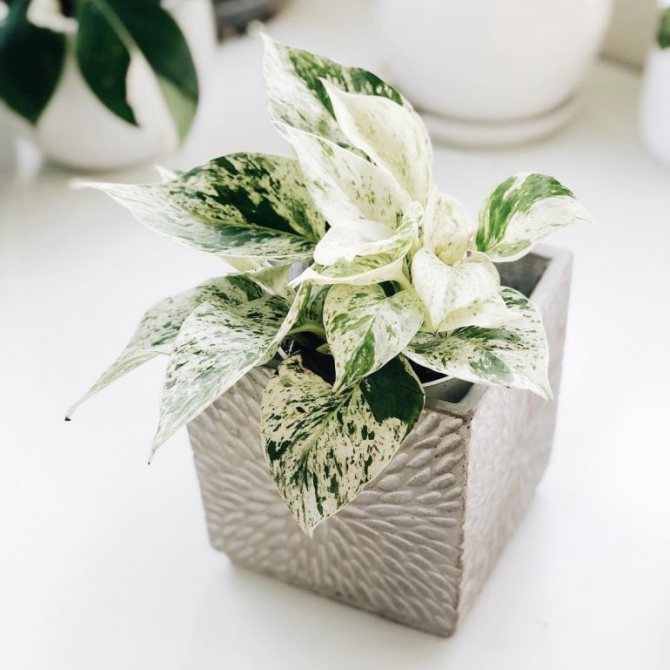

Photo of an epipremnum in a pot
Effectively cleans the air from toxic compounds, as well as:
- increase the endurance of the human body;
- have a stimulating effect on intelligence, increasing the intensity of its development;
- to have a positive impact on the state of people, both at the psycho-emotional and physical levels.
Growing epipremnum will fill the house with good spirits, optimistic mood and enthusiasm.
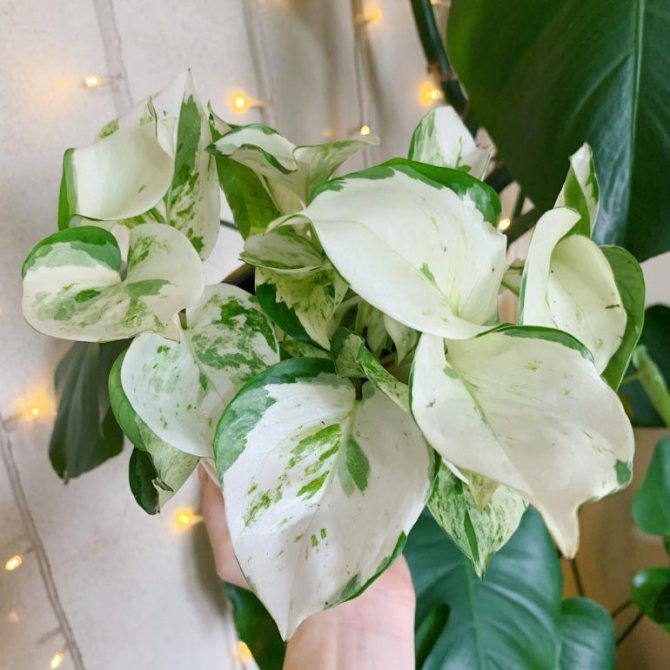

Epipremnum is golden. Photo
Pests and diseases
Among those who like to profit from plant leaves, red spider mites, scale insects, aphids and mealybugs are especially dangerous for epipremnum. These pests settle on both sides of the leaf. After a while, the leaf begins to deform and turn yellow. Red spots may form on the leaf blade, and in a dry atmosphere, the leaves curl into a tube. If you do not take action, the leaves die off, and one very long stem remains from the plant.
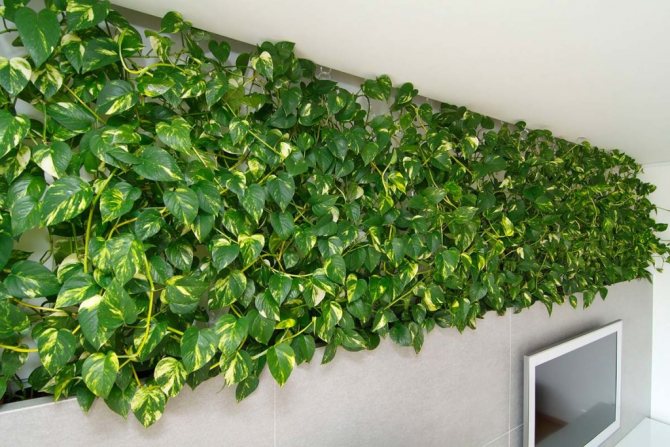

To destroy the parasites and bring the flower back to life, it is necessary to treat all the leaves with soapy water. After that, you need to thoroughly rinse the flower under warm water. At the end of the procedure, the flower is treated with a solution of karbofos. 15 drops of the drug are diluted in 1 liter of water.
There is another way to remove pests from epipremnum leaves. In a glass of water, pre-chopped onions are insisted for 24 hours. One teaspoon is enough. The resulting infusion is wiped off the leaves of the flower on both sides.
In addition to pests, the flower can be disturbed by other problems.
Leaves may begin to turn yellow and crumble if the vines lack light. For the same reason, the foliage can be small and pale, and the stem stretches several meters without a single leaf.
If there is too much sun, on the contrary, burns may appear on the epipremnum.
When a black edge or brown spots appear on the edges of the leaves, the flower may be cold and too humid. If the soil in the pot is heavily flooded, the roots and stem may begin to rot, and if the soil is too dry, the leaves of the flower will noticeably decay.
How to care for Epipremnum
Liana is placed in a lighted place. It grows well in planters or on windows. In winter, artificial light is added so that the vine does not lose its beauty. It is worth taking care that the plant does not stand in the open sun.
Monitor soil moisture closely. Liana does not like being poured over. The soil in the pot should be slightly damp. The temperature in the room where the plant grows should be comfortable. The minimum mark is 16 degrees Celsius, the maximum is 27 degrees.
The air should be moderately humid. If it is dry, spraying is used to maintain the normal level. Alternatively, place an open container of water to provide moisture when you are away.
The land for planting creepers is used universal, it is sold in any flower shop. Provide good drainage to help your plant live longer. Liana needs to be fed mineral fertilizers... A complex for indoor flowers is bought, it is divided into two parts and the plant is fed throughout the warm period of the year with a frequency of two weeks.
This variety propagates by cuttings, which are cut from the top of the shoots. It will take about a month for rooting. The stalk is placed in water, perlite or vermiculite. Growing Epipremnum Gold is easy and is more common in offices or homes.
Top dressing for golden epipremnum
Liana care involves the application of fertilizers. Most often, liquid fertilizers are used, developed specifically for plants of this type.Mineral fertilizers are purchased in specialized flower shops.
The flower is fed at least twice a month from spring to late autumn. In winter, once is enough. It is best to use fertilizers containing a complex of minerals.
The lack of nutritional components is reflected in the leaves - they become smaller, and an excess of nitrogen contributes to excessive elongation of the stems and the disappearance of the pattern from the leaf plate.
Description and photo of the plant
Golden Epipremnum stands out among other plant varieties with its beautiful dark green leaves, dotted with golden yellow streaks and spots. The size of adult plants exceeds 60 cm in length (although sometimes vines can grow up to several meters) and 30-40 cm in width. With its spectacular appearance, the variety is unpretentious in care and does not require the creation of specific conditions of humidity, illumination, temperature. The most popular varieties in culture are Marble Queen and Golden Queen.
Home care
Epipremnum, in principle, is unpretentious in care a plant that even an amateur can handle. However, there are some simple rules to follow to avoid accidentally killing the plant.
Illumination
Epipremnum loves light, but it hurts when exposed to direct sunlight. He needs a fairly diffused, but bright light.
Temperature regime
Liana easily withstands winters, but only on condition that the temperature in the room does not drop to below -10-12 degrees. In summer, the temperature should be around +20 Celsius.
Important! Try to keep the plant free from drafts. It is not necessary to "evict" the epipremnum on the balcony or in the courtyard. This is fraught with flower diseases and loss of foliage.
Watering
In winter, epipremnum, like many other plants, has a dormant period. Watering at this time should be reduced (about once every one and a half weeks, as the top layer of the earth dries out). At all other times of the year watering the plant is required about once every 5 days.
For watering and spraying, it is better to use soft, settled water at room temperature. This will reduce the risk of unpleasant stains on the foliage.
Humidity
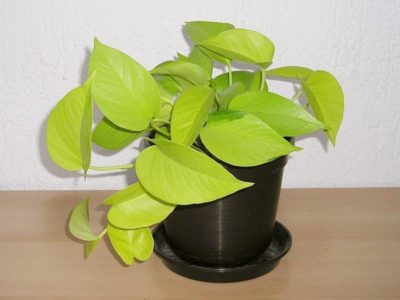

In winter, the air in apartments is often dry due to artificial heating, and in summer due to the heat. Therefore, the vine needs to be sprayed from time to time.
In addition, the leaves sometimes need to be gently wiped with a damp cloth. This not only moisturizes the plant once again, but also removes dust and dirt from it.
Transfer
During the first three years of life, the vine develops rapidly. Therefore, it will have to be transplanted into a larger pot almost every year.
An adult epipremnum, on the contrary, will be better protected from frequent movements. On average, an already formed plant is transplanted every 3 years.
Reproduction
Epipremnum is propagated in the following two ways:
Cuttings
For propagation, cuttings are chosen on which there are at least 2 leaves. Epipremnum gives roots well, even if the workpiece is simply placed in water. However, rooting is recommended to be carried out in peat mixed with moss. In this case, the new seedling is not watered until the roots form and is placed in a dark place.
Interesting! Cutting is considered a simpler and more effective way of propagating this plant.
Division of shoots into parts
In general, the method is similar to cuttings, only parts of the shoots are used as blanks, on which at least two leaves should be located.
The choice of capacity and soil for transplant
For golden epipremnum, a shallow wide container with holes in the bottom is suitable. The soil can be purchased at a specialized store or prepared by yourself. This will require one part of coarse sand, sod land and three parts of leafy soil.You can also mix in equal proportions sand with humus, turf and peat soil.
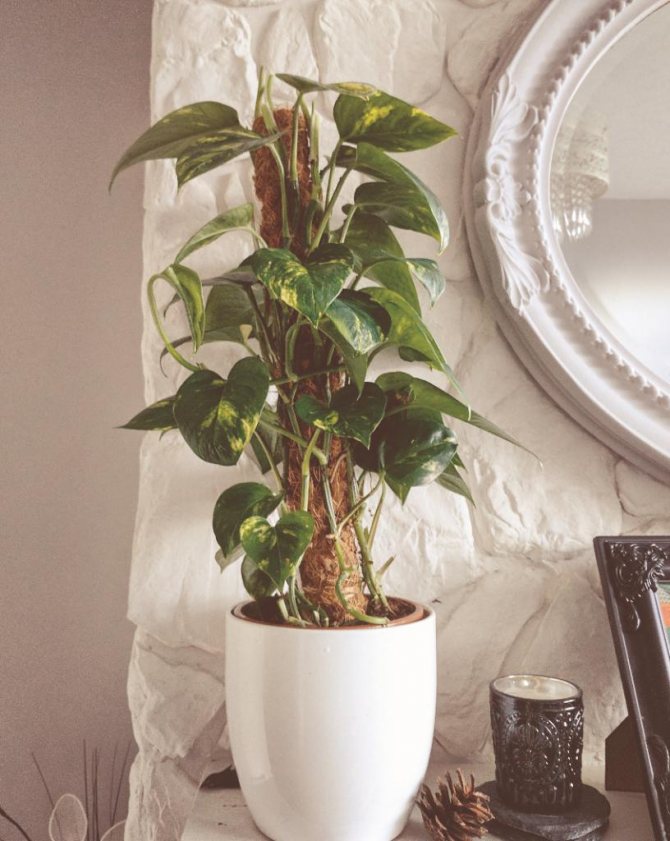

The only condition is that the soil must be moisture and breathable. A drainage layer is laid on the bottom. Vines begin replanting every three years after they reach the age of three. Until that time - annually. For young plants, take a pot with a larger diameter. No further increase in the size of the container is required. In order not to be mistaken in choosing a pot, you need to focus on the size of the root system.
Possible problems
Epipremnum is a fairly resistant plant, but it is not immune from the following problems:
- Aphids - when black clouds of this parasite appear, the plant must be washed with soapy water or sprayed with citrus peel infusion.
- Scabbard - covers the plant with brown growths. To get rid of, you will have to manually remove the insect from the leaves using special preparations.
- Spider mite - Leaves a characteristic thin patina. Often, it is enough to rinse the plant with a warm shower, but in some cases you will have to take up insecticides.
2. Improper care
If the foliage lost its variegated color and became monochromatic: the plant does not have enough light; If the leaves have faded, become translucent, whitish spots resembling burns began to appear on them: there is too much light for the plant, or it has come under the influence of direct rays; Leaves fade, wither, wither and fall: the main reason is root rot caused by excessive watering.
Important! Leaves at the bottom of the plant may begin to fall off as the plant ages. This is normal, don't be scared.
Epipremnum flower - description
Epipremnums are perennial evergreen herbaceous vines leading a semi-epiphytic lifestyle: they can exist independently or parasitize trees. Plants are fed by their fibrous root system, as well as multiple aerial roots, which, under certain conditions, can form an additional root system. Aerial roots, with the help of which the plant clings to the support, emerge from the nodes, and the aerial feeding roots from internodes. With age, both types of aerial roots become woody, and the supporting ones become corky, and the feeding ones become woody and are covered with bark of ribbon-like fibers.
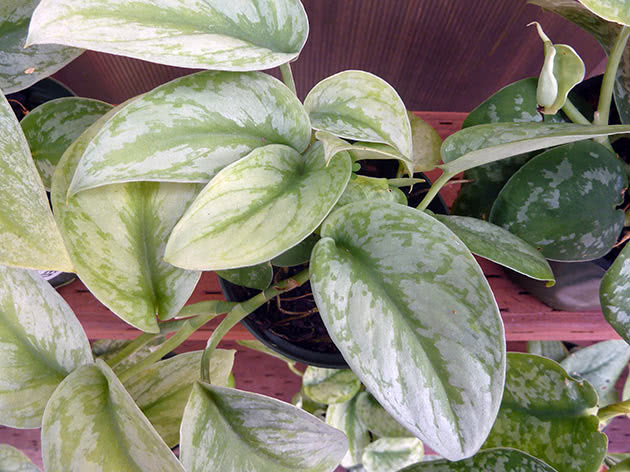

In the photo: Growing epipremnum in a pot
Epipremnum stems have the ability to cling to a support and root along their entire length. Simple, heart-shaped leaves can be thin or leathery. The leaves of adult plants reach 60 cm in length and 40 cm in width, but in young vines the foliage is smaller. With age, leaf plates can change from an integral shape to a pinnately dissected or pinnately split, and sometimes holes form in them, like in monstera leaves.
How to grow a philodendron at home - professional advice
Epipremnum flowers have no decorative value. They are collected in an inflorescence-ear, tapering towards the top, and wrapped in a canoe-shaped blanket. Epipremnums bloom only after their leaves become adults, but since this does not happen at home, flowering is rarely observed. The fruit of the epipremnum is a berry with seeds.
- Propagation of sansevieria by cuttings
Difference between epipremnum and scindapsus
Two closely related genera from the same family. But they are still different plants. Initially, only the scindapsus existed. Then the genus Epipremnum was isolated, some of the varieties were transferred to it.
Epipremnum (Epipremnum), or scindapsus is one of the most popular varieties of perennial vines, related to branchy ampelous forms of vegetation.
The flower has a huge number of varieties, but mostly it is strongly climbing vines, decorated with rich variegated green leaf blades, which can effectively decorate any interior of an office, apartment, or private house. They belong to the Aroid family.
In natural conditions, the branches of the epipremnum can reach up to 38-40 meters in length, which can spread along the ground, or attach to the trunks of various trees. The home plant grows up to 4.5 meters. He is not whimsical in leaving.
In growth, it adds up to 45 cm per year. It blooms only in natural conditions from spring to late autumn. Flowers in the form of a cob with a veil have no special value, therefore the plant has more value as a decorative one. The homeland of Epipremnum is the tropics of southeast Asia, the Slomonov Islands and the Malay archipelago, as well as Indonesia.
See also how to grow zamioculcas and syngonium.
| They have a high development rate - they add up to 45 cm per year. |
| Does not bloom at home. |
| The plant is easy to grow. Suitable for a beginner. |
| Perennial. |

